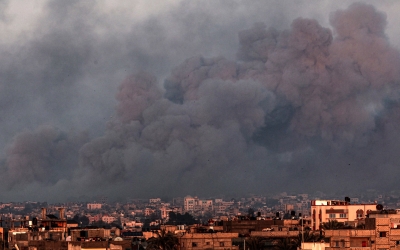War on Gaza: Israel's antiquities director displays stolen artefacts in parliament
Head of Antiquities Authorities removes Instagram posts following backlash, claiming artefacts ‘left undisturbed at site’

Photographs and videos published last week by Israel’s head of Antiquities Authority show that the Israeli military has stolen artefacts taken from Gaza that were later displayed in the Israeli parliament, known as the Knesset.
On 21 January, Eli Askozido, the director of the Israel Antiquities Authority, published a series of posts on his Instagram account, saying that his deputy went to Gaza to inspect antiquities, which are now being displayed in the Knesset.
One of his captions accompanying a photo of looted items says: “A small showcase was placed in the Knesset.”
In another video, he explains in a caption that the Israeli military contacted the authority to examine a warehouse full of antiques in Gaza.
The video shows a warehouse filled with vases, some on shelves and some on the floor while soldiers roam around. Some of the artefacts are damaged with visible cracks on them.
According to Israeli media, in one of the videos, an Israeli soldier is heard calling another and saying, “did you see the bracelets? Come see the bracelets.”
Some of the photos posted show Israeli soldiers holding tablets with engravings on them.
Askozido later took down the post and issued a statement in Hebrew on Monday saying that the items were only “examined and left undisturbed at the site”.
“The Israel Antiquities Authority was called by the Israeli army to inspect a warehouse in Gaza containing ancient items, or those that seem to be ancient. A preliminary examination was conducted by an archaeologist and a written report will be submitted to the Israeli army later,” the post on his Instagram story read.
“The items were left in their place. To avoid any doubt, the Antiquities Authority asked the Israeli army to keep the archaeological artefacts in their place.”
The post was slammed by a pro-Palestine activist, Khaled Yousry, who denounced the director and called the move a “war crime”.
In an Instagram post, Yousry wrote: “The theft of antiquities is considered a war crime according to international law. The illicit trade of cultural properties, including antiquities, is a crime under the 1970 Unesco Convention on the Measures to be Taken to Prevent the Import, Export, and Transfer of Ownership of Cultural Property.”
According to a report in Israeli media, at the start of the war, an archaeology staff officer in the Civil Administration of Judea and Samaria published a document called "Assaulting and Guarding", in which Israeli army soldiers were called to report to the Archaeology Subcommittee any finds they come across in the fighting in Gaza.
Looting
Earlier this month, the Gaza government media office said the Israeli army has, since 7 October, looted money, gold, and artefacts worth around $25m.
The media office said it had “dozens of testimonies” provided by residents of the Gaza Strip regarding the thefts.
“Theft operations occurred in various ways, the first of which was at the checkpoints, such as Salah al-Din Street, where they stole from the displaced people who had moved from the northern Gaza Strip to the south, their bags containing their valuable possessions such as money, gold, and artefacts,” the office said in a statement.
Additionally, Israeli soldiers have also looted the homes of Palestinians after they were forced to flee. Some of the looting was documented by Israeli soldiers.

Israel has come under scrutiny, as footage has emerged of troops carrying out violent and provocative acts that appear to have little to do with furthering their stated objective of destroying Hamas.
Videos shared online show theft, destruction of businesses and properties, vandalism, and the installation of Israeli and Jewish symbols across Gaza’s neighbourhoods.
In one video, a soldier bragged about stealing a silver necklace from Gaza to take back to his girlfriend in Israel. Another soldier stole a rug from a Palestinian home.
In other posts, an Israeli officer stole make-up to take as a gift to Israel, while a Palestinian musician told Middle East Eye he was shocked to discover that an Israeli soldier had stolen and played his guitar on the rubble of his destroyed home in northern Gaza.
‘Cultural genocide’
At least 195 heritage sites in Gaza, including an ancient harbour and Christian monasteries, have been destroyed or damaged since the start of the war on Gaza on 7 October.
Among the other sites destroyed include Gaza’s main public library and the historic Hamam al-Sammara (the bath of the Samaritans). The latter was believed to be the only active hammam, also known as a public bathhouse, remaining in Gaza. It is located in the Zaytoun neighbourhood of the besieged enclave.
The hammam boasted Ottoman architecture and had several rooms, each with a different temperature. It was managed by Haj Salim Abdullah al-Wazeer and the building was over 1,000 years old.
Two museums, the Rafah Museum and al-Qarara Museum, in Gaza have also been levelled, according to the International Council of Museums-Arab. The former had a collection of ancient coins, copper plates and jewellery, while the latter opened in 2016 and had a collection of 3,000 artefacts dating back to the Canaanites.
Around 1,000 out of 1,200 mosques have also been partially damaged or destroyed in Gaza, including the Othman bin Qashqar Mosque in Gaza City’s Zeitoun neighbourhood, which was built in 1220 at the site where Prophet Muhammad’s great-grandfather is believed to have been buried.
https://www.middleeasteye.net/news/war-gaza-director-israel-antiquities-artefacts-stolen-knesset


0 Comments:
Post a Comment
Subscribe to Post Comments [Atom]
<< Home